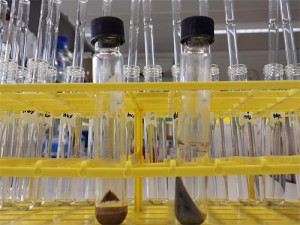Investigating poultry residues in archaeological pots

How to investigate the earliest culinary use of chickens? We believe that archaeological pots may offer some clues.
At the Department of Archaeology of the University of York we are solving this puzzle using a molecular approach. We are empirically looking for diagnostic fats in poultry meat and bone in order to search for them within archaeological pots. Animal and plant fats, waxes and oils are retained by porous ceramic vessels during the cooking process. This allows archaeologist to study them through chemical treatments and sophisticated machines (gas chromatography mass spectrometry).
However because these compounds degrade during cooking and exposure to the soil, we are also looking at other chemical evidence. In particular we are measuring the ratio of two distinct carbon atoms present in fatty acids from chickens and archaeological pots: 13C and 12C. The former carbon atom (13C) is very rare and its abundance compared to the most common 12C will depend of its source. Because preliminary studies have seen differences in the 13C/12C of chickens compared to other animals, we decided to explore further this technique to identify chickens in ancient menus.
We are now testing our biomolecular method on Anglo-Scandinavian pots from the Coppergate. Results are coming soon!
Follow us
Keep up to date with the latest project news via our Twitter feed.
- — 5 years 8 months ago
- — 6 years 5 months ago
- — 6 years 6 months ago
- — 6 years 7 months ago

 ChickenCoop
ChickenCoop